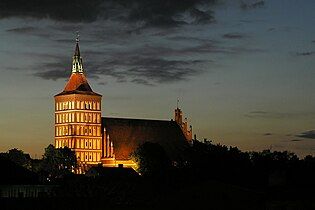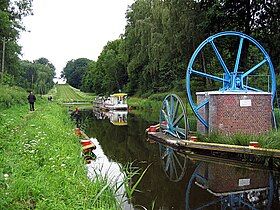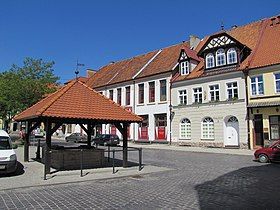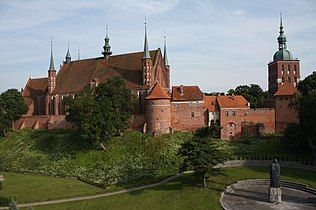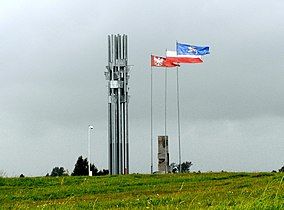Warmian–Masurian Voivodeship
Warmian–Masurian Voivodeship
Województwo warmińsko-mazurskie | |
|---|---|
 Location within Poland | |
 Division into counties | |
| Coordinates (Olsztyn): 53°47′N 20°30′E / 53.783°N 20.500°E | |
| Country | Poland |
| Capital | Olsztyn |
| Counties | 2 cities, 19 land counties * |
| Government | |
| • Body | Executive board |
| • Voivode | Radosław Król (PSL) |
| • Marshal | Marcin Kuchciński (PO) |
| • EP | Podlaskie and Warmian–Masurian |
| Area | |
• Total | 24,191.8 km2 (9,340.5 sq mi) |
| Population (2019) | |
• Total | 1,425,967 |
| • Density | 59/km2 (150/sq mi) |
| • Urban | 844,177 |
| • Rural | 581,790 |
| GDP | |
| • Total | €14.744 billion |
| • Per capita | €10,400 |
| Time zone | UTC+1 (CET) |
| • Summer (DST) | UTC+2 (CEST) |
| ISO 3166 code | PL-28 |
| Vehicle registration | N |
| HDI (2019) | 0.848[2] very high · 16th |
| Primary airport | Olsztyn-Mazury Airport |
| Highways | |
| Website | www |
Warmian–Masurian Voivodeship[a] is a voivodeship (province) in northeastern Poland. Its capital and largest city is Olsztyn. The voivodeship has an area of 24,192 km2 (9,341 sq mi) and in 2019 had a population of 1,425,967.
Warmian–Masurian Voivodeship was created on 1 January 1999 from the entire Olsztyn Voivodeship, the western half of Suwałki Voivodeship, and part of Elbląg Voivodeship, pursuant to the Polish local government reforms adopted in 1998. The province's name derives from two historic regions, Warmia and Masuria, although also parts of other regions are located within the province, i.e. of Chełmno Land and Powiśle.
The province borders Podlaskie Voivodeship to the east, Masovian Voivodeship to the south, Kuyavian-Pomeranian Voivodeship to the southwest, Pomeranian Voivodeship to the west, the Vistula Lagoon to the northwest, and the Kaliningrad Oblast (an exclave of Russia) to the north.
History
[edit]The region was originally inhabited by several Old Prussian clans, including the Bartians, Pogesanians and Warmians, from whom the name Warmia originated. During the northern Crusade, the Old Prussians were conquered by the Teutonic Order; their land was granted to the order by the pope, and the region became part of the State of the Teutonic Order. The Order encouraged colonization by German settlers in Warmia (Ostsiedlung) and Polish colonists from the region of Masovia, called Masurians (Mazurzy), hence the name Masuria. The Old Prussians were heavily decimated during the crusade and the following revolt. What remained of them became assimilated into the newcomers and thus became extinct.

During the Teutonic rule, the region experienced a process of urbanization and economic boost due to the expansion of the Hanseatic League into the region. The Order later attacked their former ally Poland and conquered the region of Pomerelia, beginning a long-lasting conflict with Poland, which subsequently entered into an alliance with Lithuania. In Masuria, the Poles and Lithuanians defeated the Order at the Battle of Grunwald. The wars eventuated in a rebellion by the urban populations of Pomerelia and Warmia, who were affected by the Teutons' numerous wars; upon the urban populations' request, the region was incorporated into Poland by King Casimir IV Jagiellon, and after the Thirteen Years' War it remained under Polish suzerainty, but was divided into two parts: Elbląg and Warmia were incorporated directly into the Kingdom of Poland, while Masuria became a Polish fief under the control of the Teutonic Order, also considered an integral part of "one and indivisible" Kingdom of Poland.[3]

The state of the Teutonic Order ceased to exist in 1525 when Grandmaster Albert Hohenzollern introduced secularisation, proclaimed the Duchy of Prussia, and became a vassal of Sigismund I of Poland. The Prussian Hohenzollern line became extinct in 1618 with the death of Albert Frederick, and the Duchy was inherited by the Brandenburgian line; Prussia simultaneously entered into a personal union with the electorate of Brandenburg known as Brandenburg-Prussia, remaining under Polish suzerainty until the Treaty of Oliva in 1660. The throne was inherited by Frederick I of Prussia who wanted to unite the Duchy with Brandenburg and also wanted to proclaim himself king of Prussia and therefore participated in the Russian-initiated Partitions of Poland in which Warmia was annexed by the Kingdom of Prussia, and henceforth became part of the newly established province of East Prussia. Together with the rest of the Kingdom, the region became part of the North German Confederation and the German Empire.

In 1914, the province turned into a battlefield, seeing notable battles such as the Battle of Tannenberg as part of the Eastern Front of World War I. Later, the region became part of the Weimar Republic, and Nazi Germany, whereas some areas in the south became again part of Poland, following the restoration of its independence in 1918. In the interbellum, the Polish population was subjected to persecution from both the pre-Nazi and Nazi authorities of Germany. With the German invasion of Poland at the start of World War II in 1939, the Germans eventually carried out mass arrests of local Poles, shut down or seized Polish newspapers and libraries,[4] and occupied the pre-war Polish areas of the present-day province, in which they established the Soldau concentration camp, and carried out massacres of Poles, including at Bratian, Nawra, Malinowo and Komorniki.[5] Several subcamps of the Stutthof concentration camp were located in the region. Stalag I-B, a major German prisoner-of-war camp for Polish, Belgian, French, Italian, Serbian and Soviet POWs,[6] and Wolf's Lair, Adolf Hitler's first Eastern Front military headquarters were located in Masuria. After the end of World War II, the German population was expelled in accordance with the Potsdam Agreement, whereas many Masurians emigrated in the following decades.
Ethnic and religious structure
[edit]In year 1824, shortly before its merger with West Prussia, the population of East Prussia was 1,080,000 people.[7] Of that number, according to Karl Andree, Germans were slightly more than half, while 280,000 (~26%) were ethnically Polish and 200,000 (~19%) were ethnically Lithuanian,[8] however large portions of its German and Lithuanian populations lived in the northern half of the region, outside of the present Warmian–Masurian Voivodeship. As of year 1819 there were also some 2,400 Jews, according to Georg Hassel.[9] Similar numbers are given by August von Haxthausen in his 1839 book, with a breakdown by county.[10] But the majority of East Prussian Polish and Lithuanian inhabitants were Lutherans, not Roman Catholics like their ethnic kinsmen across the border in the Russian Empire. Only in Southern Warmia Catholic Poles – so called Warmiaks (not to be confused with predominantly Protestant Masurians) – comprised the majority of population, numbering 26,067 people (~81%) in county Allenstein (Polish: Olsztyn) in 1837.[10] Another minority in 19th-century East Prussia, were ethnically Russian Old Believers, also known as Philipponnen – their main town was Eckersdorf (Wojnowo).[11][12][13] The Polish population was subjected to Germanisation and Kulturkampf policies.
In year 1817, East Prussia had 796,204 Evangelical Christians, 120,123 Roman Catholics, 864 Mennonites and 2,389 Jews.[14]
The Warmian–Masurian Voivodeship has the largest number of ethnic Ukrainians living in Poland[15] due to forced relocations (such as Operation Vistula) carried out by the Soviet and Polish Communist authorities.
Pasłęk in the western part of the voivodeship is considered the first place in present-day Poland where Dutch immigrants settled (in 1297).[16] There is a claim that they were participants in the killing of Floris V, Count of Holland in 1296, who then fled east, which is alluded to by Dutch poet Joost van den Vondel in his work Gijsbrechcie van Aemstel (1637).[17]
Cities and towns
[edit]




| Year | Pop. | ±% |
|---|---|---|
| 1988 | 1,397,997 | — |
| 2002 | 1,428,357 | +2.2% |
| 2011 | 1,452,147 | +1.7% |
| 2021 | 1,382,232 | −4.8% |
| Source: [18] | ||
The Voivodeship contains three cities and 47 towns. These are listed below in descending order of population (according to official figures for 2019):[19]
Towns:
- Iława (33,322)
- Ostróda (32,947)
- Giżycko (29,335)
- Kętrzyn (27,212)
- Bartoszyce (23,482)
- Szczytno (23,267)
- Mrągowo (21,656)
- Działdowo (21,279)
- Pisz (19,277)
- Braniewo (17,040)
- Olecko (16,442)
- Lidzbark Warmiński (15,728)
- Morąg (13,793)
- Nidzica (13,762)
- Gołdap (13,716)
- Pasłęk (12,160)
- Węgorzewo (11,328)
- Nowe Miasto Lubawskie (10,891)
- Biskupiec (10,598)
- Lubawa (10,387)
- Dobre Miasto (10,208)
- Orneta (8,772)
- Lidzbark (7,794)
- Olsztynek (7,561)
- Barczewo (7,513)
- Susz (5,560)
- Orzysz (5,546)
- Reszel (4,532)
- Ruciane-Nida (4,454)
- Korsze (4,206)
- Biała Piska (4,024)
- Górowo Iławeckie (3,951)
- Mikołajki (3,826)
- Jeziorany (3,190)
- Wielbark (3,035)
- Ryn (2,851)
- Pieniężno (2,721)
- Tolkmicko (2,689)
- Miłakowo (2,548)
- Pasym (2,503)
- Miłomłyn (2,436)
- Bisztynek (2,370)
- Frombork (2,332)
- Zalewo (2,145)
- Kisielice (2,098)
- Sępopol (1,958)
- Młynary (1,772)
Administrative division
[edit]
Warmian–Masurian Voivodeship is divided into 21 counties (powiaty): two city counties and 19 land counties. These are further divided into 116 gminas.
The counties are listed in the following table (ordering within categories is by decreasing population).
| English and Polish names |
Area (km2) |
Population (2019) |
Seat | Other towns | Total gminas |
| City counties | |||||
| Olsztyn | 88 | 172,194 | 1 | ||
| Elbląg | 80 | 119,760 | 1 | ||
| Land counties | |||||
| Olsztyn County powiat olsztyński |
2,840 | 126,334 | Olsztyn * | Dobre Miasto, Biskupiec, Olsztynek, Barczewo, Jeziorany | 12 |
| Ostróda County powiat ostródzki |
1,765 | 104,526 | Ostróda | Morąg, Miłakowo, Miłomłyn | 9 |
| Iława County powiat iławski |
1,385 | 92,933 | Iława | Lubawa, Susz, Kisielice, Zalewo | 7 |
| Ełk County powiat ełcki |
1,112 | 91,446 | Ełk | 5 | |
| Szczytno County powiat szczycieński |
1,933 | 69,678 | Szczytno | Pasym, Wielbark | 8 |
| Kętrzyn County powiat kętrzyński |
1,213 | 62,536 | Kętrzyn | Reszel, Korsze | 6 |
| Działdowo County powiat działdowski |
953 | 65,288 | Działdowo | Lidzbark | 6 |
| Bartoszyce County powiat bartoszycki |
1,309 | 57,642 | Bartoszyce | Górowo Iławeckie, Bisztynek, Sępopol | 6 |
| Pisz County powiat piski |
1,776 | 56,328 | Pisz | Orzysz, Ruciane-Nida, Biała Piska | 4 |
| Giżycko County powiat giżycki |
1,119 | 56,661 | Giżycko | Ryn | 6 |
| Elbląg County powiat elbląski |
1,431 | 57,395 | Elbląg * | Pasłęk, Tolkmicko, Młynary | 9 |
| Mrągowo County powiat mrągowski |
1,065 | 49,970 | Mrągowo | Mikołajki | 5 |
| Braniewo County powiat braniewski |
1,205 | 41,223 | Braniewo | Pieniężno, Frombork | 7 |
| Nowe Miasto County powiat nowomiejski |
695 | 43,900 | Nowe Miasto Lubawskie | 5 | |
| Lidzbark County powiat lidzbarski |
924 | 41,311 | Lidzbark Warmiński | Orneta | 5 |
| Olecko County powiat olecki |
874 | 34,281 | Olecko | 4 | |
| Nidzica County powiat nidzicki |
961 | 32,940 | Nidzica | 4 | |
| Gołdap County powiat gołdapski |
772 | 26,825 | Gołdap | 3 | |
| Węgorzewo County powiat węgorzewski |
693 | 22,796 | Węgorzewo | 3 | |
| * seat not part of the county | |||||
Sights and tourism
[edit]
Amongst the most visited sights is the Masurian Lake District, which contains more than 2,000 lakes, including the largest lakes of Poland, Śniardwy and Mamry. Giżycko, Iława, Mrągowo, Mikołajki and Ruciane-Nida are thus popular summer destinations.
Other recognizable landmarks are the Warmian castles (Lidzbark Warmiński Castle, Pieniężno Castle, Olsztyn Castle) and the Cathedral Hill in Frombork, where Polish astronomer Nicolaus Copernicus lived and worked, and which contains his tomb. In collections of the Warmia and Mazury Museum in Olsztyn, visitors can find numerous tokens from the time when Nicolaus Copernicus lived in Warmia.[20] The Lidzbark Warmiński Castle was later the residence of Ignacy Krasicki, nicknamed the Prince of Polish Poets. There are also multiple other Gothic castles and palaces in various styles in the voivodeship. Święta Lipka in Masuria and Gietrzwałd in Warmia are popular pilgrimage sites, and other notable historic churches include the Gothic collegiate church in Dobre Miasto and churches in Orneta and Kętrzyn, which delight visitors with the uniqueness of their architectonic details. Several towns contain entirely or partly preserved medieval town walls with towers and gates, i.e. Lidzbark Warmiński, Nowe Miasto Lubawskie, Pasłęk.
The Elbląg Canal is considered one of the greatest landmarks of the western part of the province. The Grunwald battlefield in Masuria is site of the annual reenactment of one of the largest battles of Medieval Europe. Gołdap is a spa town in the north-eastern part of the province. There is a museum dedicated to composer Feliks Nowowiejski at his birthplace in Barczewo.
There are multiple World War II memorials in the voivodeship, including at the site of the Soldau concentration camp in Działdowo, at the locations of Nazi massacres of Poles, and the war cemetery in Sudwa, where victims of the Stalag I-B German prisoner-of-war camp were buried. The Wolf's Lair, Adolf Hitler's first Eastern Front military headquarters in World War II is located in Gierłoż.
Protected areas
[edit]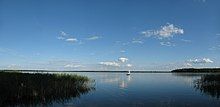
Protected areas in Warmian–Masurian Voivodeship include eight areas designated as Landscape Parks, as listed below:
- Brodnica Landscape Park (partly in Kuyavian-Pomeranian Voivodeship)
- Dylewo Hills Landscape Park
- Elbląg Upland Landscape Park
- Górzno-Lidzbark Landscape Park (partly in Kuyavian-Pomeranian and Masovian Voivodeships)
- Iława Lake District Landscape Park (partly in Pomeranian Voivodeship)
- Masurian Landscape Park
- Puszcza Romincka Landscape Park
- Wel Landscape Park
The Łuknajno Lake nature reserve (part of Masurian Landscape Park) is a protected wetland site under the Ramsar convention, as well as being designated by UNESCO as a biosphere reserve.
Cuisine
[edit]In addition to traditional nationwide Polish cuisine, Warmian–Masurian Voivodeship has its variety of traditional foods and drinks, specific to its Warmia and Masuria regions, officially protected by the Ministry of Agriculture and Rural Development of Poland. Masuria produces several types of various meat products, especially kiełbasa, and a plethora of traditional Polish honey. Masuria also shares with neighboring Podlaskie Voivodeship the tradition of producing sękacz, a traditional spit cake of northeastern Poland.
The protected traditional alcoholic beverages of the province are Okowita miodowa warmińska, a beverage of 42% alcohol by volume made from Warmian honey, the Warmian porter, a local type of Polish beer, and Masurian nalewka niedźwiedziówka.[21][22]
Education
[edit]
The chief institutions of higher learning in the voivodeship are the University of Warmia and Mazury in Olsztyn and Higher State College of Vocational Education in Elbląg. Kortowiada, one of the largest annual university students' holidays in Poland, is held in Olsztyn.
The Police Academy in Szczytno, the main police academy in Poland, is located in the voivodeship.
International relations
[edit]28 towns are members of Cittaslow, more than in any other province of Poland.[23]
Twin towns – sister cities
[edit]The Warmian–Masurian Voivodeship is twinned with:
Sports
[edit]| Club | Sport | League | Trophies |
|---|---|---|---|
| AZS Olsztyn | Volleyball (men's) | PlusLiga | 5 Polish Championships 7 Polish Cups |
| Start Elbląg | Handball (women's) | Superliga | 2 Polish Championships (1992, 1994) 3 Polish Cups (1993, 1994, 1999) |
| Olimpia Elbląg | Football (men's) | II liga | 0 |
| Stomil Olsztyn | Football (men's) | II liga | 0 |
| Stomilanki Olsztyn | Football (women's) | Ekstraliga | 0 |
| Constract Lubawa | Futsal (men's) | Ekstraklasa | 1 Polish Cup (2020) |
Gallery
[edit]- Popular attractions and tourist destinations
-
St. James' Cathedral in Olsztyn
-
Reszel historic town center
-
Collegiate church in Dobre Miasto
-
Sanctuary of Saint Mary in Święta Lipka
-
Birthplace of composer Feliks Nowowiejski in Barczewo
-
Łuczański Canal and the swing bridge in Giżycko
-
Grunwald battlefield
See also
[edit]- Masurian dialects
- Nidka river
Notes
[edit]- ^ Polish: Województwo warmińsko-mazurskie, pronounced [vɔjɛˈvut͡stfɔ varˈmij̃skɔ maˈzurskʲɛ] .
References
[edit]- ^ "EU regions by GDP, Eurostat". Retrieved 18 September 2023.
- ^ "Sub-national HDI - Subnational HDI - Global Data Lab". globaldatalab.org. Radboud University Nijmegen. Retrieved 13 December 2021.
- ^ Górski, Karol (1949). Związek Pruski i poddanie się Prus Polsce: zbiór tekstów źródłowych (in Polish). Poznań: Instytut Zachodni. pp. 96–97, 214–215.
- ^ Cygański, Mirosław (1984). "Hitlerowskie prześladowania przywódców i aktywu Związków Polaków w Niemczech w latach 1939-1945". Przegląd Zachodni (in Polish) (4): 41–42.
- ^ Wardzyńska, Maria (2009). Był rok 1939. Operacja niemieckiej policji bezpieczeństwa w Polsce. Intelligenzaktion (in Polish). Warsaw: IPN. pp. 177, 228–229, 235–236.
- ^ Megargee, Geoffrey P.; Overmans, Rüdiger; Vogt, Wolfgang (2022). The United States Holocaust Memorial Museum Encyclopedia of Camps and Ghettos 1933–1945. Volume IV. Indiana University Press, United States Holocaust Memorial Museum. p. 390. ISBN 978-0-253-06089-1.
- ^ Plater, Stanisław (1825). Jeografia wschodniéy części Europy czyli Opis krajów przez wielorakie narody słowiańskie zamieszkanych: obejmujący Prussy, Xsięztwo Poznańskie, Szląsk Pruski, Gallicyą, Rzeczpospolitę Krakowską, Krolestwo Polskie i Litwę (in Polish). Wrocław: u Wilhelma Bogumiła Korna. p. 17.
- ^ Andree, Karl (1831). Polen: in geographischer, geschichtlicher und culturhistorischer Hinsicht (in German). Verlag von Ludwig Schumann. p. 218.
- ^ Hassel, Georg (1823). Statistischer Umriß der sämmtlichen europäischen und der vornehmsten außereuropäischen Staaten, in Hinsicht ihrer Entwickelung, Größe, Volksmenge, Finanz- und Militärverfassung, tabellarisch dargestellt; Erster Heft: Welcher die beiden großen Mächte Österreich und Preußen und den Deutschen Staatenbund darstellt (in German). Verlag des Geographischen Instituts Weimar. p. 41.
- ^ a b Haxthausen, August (1839). Die Ländliche Verfassung in den Einzelnen Provinzen der Preussischen Monarchie (in German). pp. 75–91.
- ^ "Monastery of the Dormition of the Mother of God in Wojnowo (Eckersdorf)". wojnowo.net.
- ^ Tetzner, Franz (1902). Die Slawen in Deutschland: beiträge zur volkskunde der Preussen, Litauer und Letten, der Masuren und Philipponen, der Tschechen, Mährer und Sorben, Polaben und Slowinzen, Kaschuben und Polen. Braunschweig: Verlag von F. Vieweg. pp. 212–248.
- ^ "Old Believers in Poland – historical and cultural information". Poland's Linguistic Heritage.
- ^ Hoffmann, Johann Gottfried (1818). Übersicht der Bodenfläche und Bevölkerung des Preußischen Staates : aus den für das Jahr 1817 mtlich eingezogenen Nachrichten. Berlin: Decker. p. 51.
- ^ (in Polish) Mniejszości narodowe i etniczne w Polsce on the pages of Polish Ministry of Internal Affairs and Administration. Retrieved on 9 September 2007
- ^ Słownik geograficzny Królestwa Polskiego i innych krajów słowiańskich, Tom III (in Polish). Warszawa: nakł. Filipa Sulimierskiego i Władysława Walewskiego. 1882. p. 96.
- ^ Morciniec, Norbert (2019). Historia literatury niderlandzkiej do końca 19. wieku (in Polish). Wrocław: Oficyna Wydawnicza ATUT. p. 106. ISBN 978-83-7977-424-1.
- ^ "Statistics Poland - National Censuses".
- ^ GUS. "Population. Size and structure and vital statistics in Poland by territorial division in 2019. As of 30th June". stat.gov.pl. Retrieved 11 September 2020.
- ^ Związek Województw Rzeczypospolitej Polskiej (Union of the Voivodeships of the Republic of Poland) (2010). Polska — Rozwój Regionów.
- ^ "Okowita miodowa warmińska". Ministerstwo Rolnictwa i Rozwoju Wsi - Portal Gov.pl (in Polish). Retrieved 23 May 2024.
- ^ "Porter warmiński". Ministerstwo Rolnictwa i Rozwoju Wsi - Portal Gov.pl (in Polish). Retrieved 23 May 2024.
- ^ "Welcome to Cittaslow International". Retrieved 21 May 2024.
- ^ "Podolsk sister cities". Retrieved 29 April 2010.





